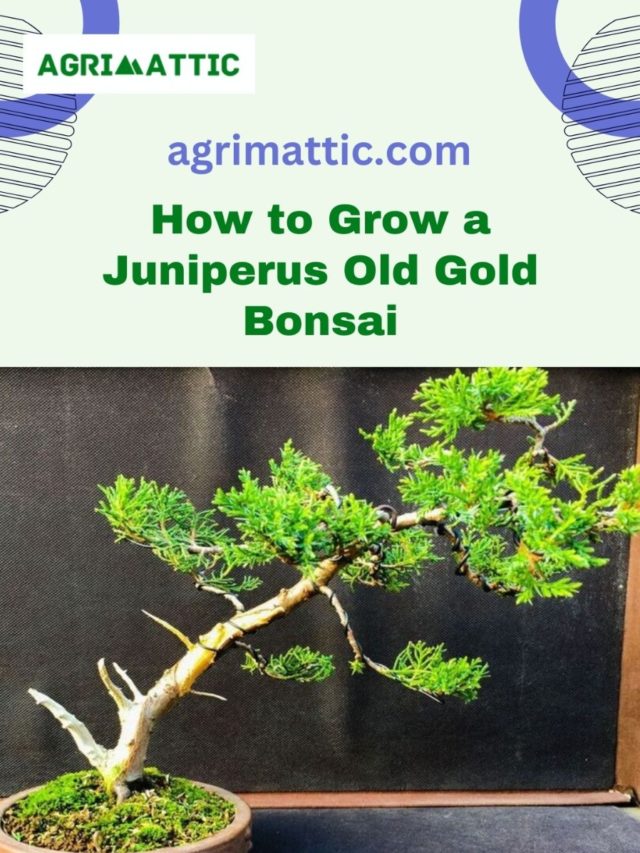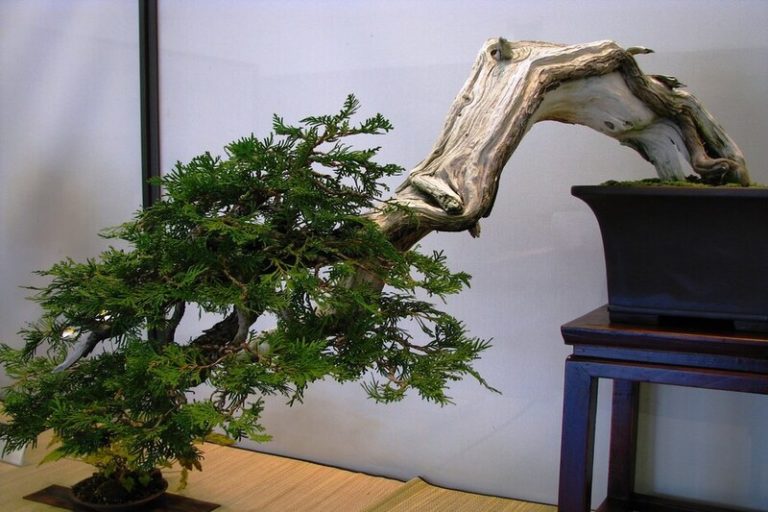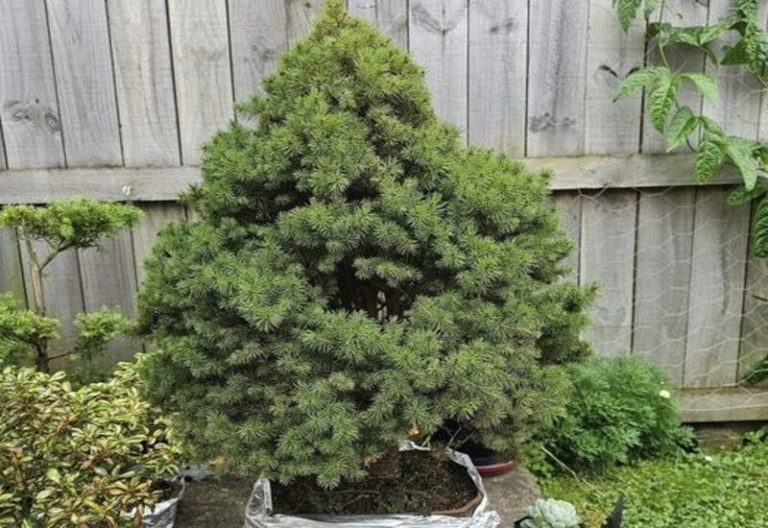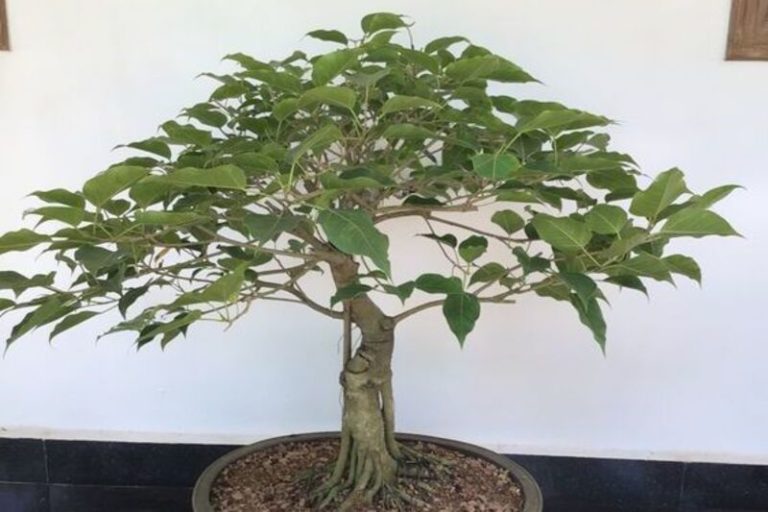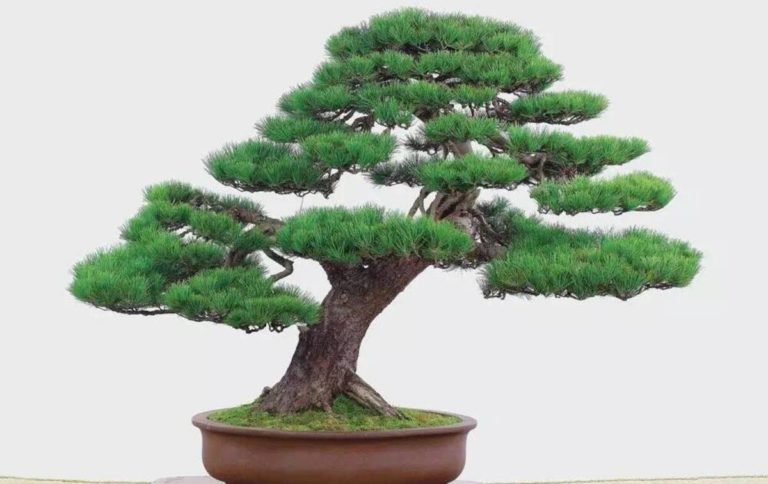Juniperus Old Gold Bonsai : A Golden Delight for Bonsai Enthusiasts
Juniperus Old Gold Bonsai is a beautiful and captivating plant that can bring a touch of nature’s serenity to your home or garden. In this article, we will explore the basics of growing and caring for Juniperus Old Gold Bonsai, as well as tips for styling and showcasing this stunning plant.
What is a Juniperus Old Gold Bonsai?
Juniperus Old Gold Bonsai is a variety of juniper tree cultivated specifically for bonsai. It stands out for its striking golden foliage, which remains vibrant throughout the year. This small evergreen tree reaches a height of 2–3 feet and prefers full sun exposure. It requires well-draining soil and proper care in terms of watering, pruning, and fertilization. Juniperus Old Gold Bonsai is favored by bonsai enthusiasts for its unique and visually appealing golden foliage, making it a beautiful addition to any bonsai collection.
History and Origins of the Juniperus Old Gold Bonsai
The Juniperus Old Gold Bonsai, scientifically known as Juniperus x media ‘Old Gold,’ has a fascinating history and origins. It is a cultivar that was developed through selective breeding and hybridization.
Juniperus chinensis and Juniperus sabina are the parent species of Juniperus Old Gold Bonsai. These two juniper species are endemic to Asia, specifically China, Japan, and Mongolia. They have long been praised for their decorative properties and are grown for a variety of reasons, including bonsai.
Juniperus chinensis and Juniperus sabina are the species from which Juniperus Old Gold Bonsai came. Both of these kinds of juniper are native to parts of Asia, such as China, Japan, and Mongolia. They have been liked for a long time because they look nice and have been grown for many reasons, including bonsai.
The goal was to come up with a juniper type that was small, had pretty leaves, and grew in a way that would be good for training and shaping as a bonsai. Juniperus Old Gold Bonsai is a variety that was made by carefully crossing plants and choosing the best ones. It has distinctive golden leaves.
Juniperus Old Gold Bonsai acquired popularity among bonsai enthusiasts over time due to its distinct color and visual attractiveness. It quickly became a popular option for bonsai collections and has been loved by fans all around the world.
Today, Juniperus Old Gold Bonsai represents the result of years of selective breeding and hybridization efforts to create a stunning variety of juniper specifically tailored for bonsai cultivation. Its rich history and origins contribute to its value and allure in the world of bonsai.
Juniperus Old Gold Bonsai and Their Symbolism
Juniperus Old Gold Bonsai, with its captivating golden foliage, carries symbolism and significance in various cultural and philosophical contexts. Here are some symbolic meanings associated with Juniperus Old Gold Bonsai:
1. Prosperity and Abundance: The golden color of the foliage is often associated with wealth, prosperity, and abundance. In bonsai culture, having a healthy and thriving Juniperus Old Gold Bonsai can symbolize material success and good fortune.
2. Beauty and Elegance: The unique golden foliage of Juniperus Old Gold Bonsai represents beauty and elegance. Its striking appearance adds a touch of warmth and refinement to any space, making it a prized choice for bonsai enthusiasts who appreciate aesthetic appeal.
3. Longevity and Resilience: In general, juniper plants are known for being long-lived and able to stand up to harsh environments. Juniperus Old Gold Bonsai has these same traits, which show that it is strong and can last. In the art of bonsai, it represents the time and effort needed to care for and grow a bonsai tree that will last for a long time.
4. Harmony and Balance: Bonsai cultivation aims to create harmony and balance between the tree’s natural growth and the artist’s shaping techniques. Juniperus Old Gold Bonsai, with its well-proportioned branches and foliage, embodies the ideal balance and harmonious aesthetics sought in bonsai art.
5. Zen and Meditation: Bonsai has strong ties to Zen Buddhism and the practice of meditation. The process of tending to a Juniperus Old Gold Bonsai can be a meditative and mindful activity, encouraging a sense of inner peace, tranquility, and connection with nature.
It’s important to note that symbolic meanings can vary across cultures and individuals. The symbolism of Juniperus Old Gold Bonsai may be interpreted differently based on personal beliefs and cultural contexts. Ultimately, the symbolic significance of this bonsai tree is open to individual interpretation and appreciation.
Characteristics of the Juniperus Old Gold Bonsai
The Juniperus Old Gold Bonsai possesses distinct characteristics that contribute to its symbolism and significance. Here are some key characteristics of Juniperus Old Gold Bonsai and their symbolic meanings:
Golden Foliage: The most prominent feature of Juniperus Old Gold Bonsai is its golden-colored foliage. The golden hue represents wealth, prosperity, and abundance. It symbolizes success, good fortune, and the fulfillment of desires.
Evergreen Nature: As an evergreen tree, Juniperus Old Gold Bonsai retains its foliage throughout the year. This characteristic represents resilience, endurance, and permanence. It symbolizes the ability to withstand challenges and maintain strength and vitality.
Compact Size: Juniperus Old Gold Bonsai is a small tree that can reach a height of 2–3 feet. Its compact size symbolizes harmony, balance, and simplicity. It represents the pursuit of equilibrium in life and the importance of finding beauty in the small and delicate aspects of existence.
Needle-like Leaves: The needle-like leaves of Juniperus Old Gold Bonsai symbolize focus, sharpness, and precision. They represent the importance of attention to detail and the need for careful cultivation to achieve desired results.
Bonsai Artistry: Juniperus Old Gold Bonsai is often cultivated as a bonsai, which adds another layer of symbolism. Bonsai itself is a form of art that symbolizes patience, discipline, and the appreciation of nature’s beauty. The shaping and styling of Juniperus Old Gold Bonsai reflect the artist’s creativity and the cultivation of inner peace and tranquility.
Connection to Nature: Juniperus Old Gold Bonsai, like all bonsai trees, connects us to the natural world. It symbolizes our bond with nature, reminding us of the importance of conservation, harmony, and the interdependence of all living things.
It’s important to remember that even though these qualities and meanings are often linked to Juniperus Old Gold Bonsai, different people and cultures may see things differently. Juniperus Old Gold Bonsai can mean different things to different people. This means that each person can find their own greater meanings and links with this beautiful bonsai tree.
How to Grow a Juniperus Old Gold Bonsai
Growing a Juniperus Old Gold Bonsai can be a rewarding and enjoyable experience. Here are some steps to guide you in successfully cultivating and caring for your Juniperus Old Gold Bonsai:
- Selecting a Healthy Bonsai: Choose a healthy Juniperus Old Gold Bonsai plant from a reputable nursery or bonsai supplier. Look for a tree with vibrant golden foliage, well-distributed branches, and a strong root system.
- Choosing the Right Container: Select a bonsai container that provides adequate drainage and is proportionate to the size of your Juniperus Old Gold Bonsai. The pot should have drainage holes to prevent waterlogging.
- Soil Selection: Use a well-draining bonsai soil mix that consists of a combination of inorganic components like grit and perlite and organic components like peat moss or pine bark. This type of soil ensures proper water drainage and aeration for the roots.
- Positioning and Light: Place your Juniperus Old Gold Bonsai in a location that receives ample sunlight. Ideally, it should receive at least 6–8 hours of direct sunlight per day. This will help promote healthy growth and maintain the golden color of the foliage.
- Watering: Water your Juniperus Old Gold Bonsai thoroughly when the top inch of soil feels dry. Avoid overwatering, as excessive moisture can lead to root rot. Ensure that water drains completely from the drainage holes.
- Pruning and Shaping: Regular pruning is essential to maintaining the desired shape and form of your Juniperus Old Gold Bonsai. Prune back new growth, remove any dead or unhealthy branches, and maintain a balanced structure. Use bonsai pruning tools for precision and avoid excessive pruning.
- Fertilization: Feed your Juniperus Old Gold Bonsai with a balanced bonsai fertilizer during the growing season (spring to fall). Follow the instructions on the fertilizer package for the appropriate dosage. This will provide essential nutrients for healthy growth.
- Wiring and Styling: Wiring can be used to shape and place branches, letting you make a bonsai in the way you want. Be careful when connecting the tree so you don’t hurt it. Take the lines down before they start to hurt the trees.
- Protection from Harsh Weather: During extreme cold or hot weather, consider protecting your Juniperus Old Gold Bonsai. You can move it indoors or provide some form of shelter to prevent damage from frost or the scorching sun.
- Regular Care and Maintenance: Keep an eye out for pests like spider mites and aphids, and if you see a lot of them, move quickly. Check your bonsai regularly for signs of disease or lack of nutrients and treat them as needed.
By following these guidelines and providing proper care, you can cultivate a healthy and visually stunning Juniperus Old Gold Bonsai. Remember that bonsai cultivation requires patience, attention to detail, and a deep appreciation for the artistry of nature. Enjoy the journey of growing and nurturing your Juniperus Old Gold Bonsai tree.
Benefits of the Juniperus Old Gold Bonsai
The Juniperus Old Gold Bonsai offers several benefits that make it a desirable choice for bonsai enthusiasts. Here are some of the benefits of cultivating a Juniperus Old Gold Bonsai:
Visual Appeal: The Juniperus Old Gold Bonsai is known for its stunning golden foliage, which adds a touch of elegance and beauty to any space. Its vibrant color stands out and can be a focal point in a bonsai collection or garden.
Compact Size: Juniperus Old Gold Bonsai is a small tree, making it suitable for cultivation in limited spaces. Its compact form allows it to be grown indoors or on balconies, patios, or small gardens, bringing the beauty of bonsai to any setting.
Low Maintenance: Juniperus Old Gold Bonsai is relatively low maintenance compared to some other bonsai varieties. It is a hardy plant that can tolerate different weather conditions and requires minimal watering and pruning. This makes it an ideal choice for beginners or those with busy lifestyles.
Longevity: With proper care, Juniperus Old Gold Bonsai can live for many years, even decades. It has the potential to become a long-term companion, offering years of enjoyment and beauty.
Symbolic Significance: The golden foliage of Juniperus Old Gold Bonsai carries symbolic meanings such as prosperity, abundance, and elegance. Cultivating this bonsai tree allows you to connect with its symbolic qualities and appreciate the deeper meanings associated with them.
Bonsai Artistry: Growing and shaping a Juniperus Old Gold Bonsai allows you to engage in the art of bonsai. It offers an opportunity for self-expression, creativity, and a sense of accomplishment as you carefully train and shape the tree into your desired bonsai style.
Stress Relief and Mindfulness: Caring for a Juniperus Old Gold Bonsai can be a therapeutic and relaxing activity. It encourages mindfulness as you focus on the tree’s needs, providing a calming and meditative experience that helps reduce stress and enhance overall well-being.
Connection with Nature: Bonsai, like Juniperus Old Gold Bonsai, is a way to connect with nature. It lets you watch and admire how a living thing grows and changes, giving you a sense of balance and respect for the natural world.
Whether you are a bonsai aficionado or wanting to add a touch of natural beauty to your living space, the Juniperus Old Gold Bonsai has various advantages that may enrich your surroundings and give a full and rewarding bonsai experience.

Displaying and Showcasing the Juniperus Old Gold Bonsai
Displaying and showcasing your Juniperus Old Gold Bonsai is an exciting aspect of bonsai cultivation. Here are some tips to help you present your Juniperus Old Gold Bonsai in an appealing and captivating manner:
Bonsai Stand or Table: Choose a suitable stand or table to elevate your Juniperus Old Gold Bonsai and create a focal point for display. Look for a stand that complements the size and style of your bonsai. Wooden or stone stands often work well, providing a natural and harmonious backdrop.
Proper Lighting: Position your Juniperus Old Gold Bonsai in a well-lit area to showcase its golden foliage. Natural sunlight is ideal, but if that is not possible, consider using artificial grow lights specifically designed for bonsai. Proper lighting enhances the color and detail of your bonsai, making it more visually appealing.
Background and Complementary Elements: Choose a backdrop or background that enhances the beauty of your Juniperus Old Gold Bonsai. A simple and uncluttered background, such as a plain wall or a neutral-colored screen, allows the bonsai to stand out. Additionally, you can add complementary elements like small accent plants, rocks, or figurines to create a harmonious and balanced display.
Consider Seasonal Displays: Juniperus Old Gold Bonsai can be displayed differently throughout the year to reflect the changing seasons. During spring and summer, you can highlight the vibrant golden foliage against a backdrop of fresh greenery. In the fall, you might accentuate the bonsai with autumn-colored leaves or decorative elements. Adapting your display to the seasons adds variety and interest.
Showcasing Branch Structure: Juniperus Old Gold Bonsai often have intricate and visually appealing branch structures. Highlight these unique features by carefully positioning and arranging the branches. Use bonsai wire to gently shape and style the branches, emphasizing the natural flow and movement.
Rotation and Viewing Angles: Rotate your Juniperus Old Gold Bonsai on a regular basis so that all sides get the same amount of light. This helps the plant grow evenly and keep its shape. Try looking at your bonsai from different directions to find the most pleasing way to see it.
Bonsai Exhibitions and Shows: Consider participating in bonsai exhibitions or shows to showcase your Juniperus Old Gold Bonsai to a wider audience. These events provide opportunities to display your bonsai alongside other enthusiasts’ creations and gain valuable feedback and inspiration.
Remember, displaying your Juniperus Old Gold Bonsai is a creative process that allows you to express your personal style and appreciation for bonsai art. Experiment with different display techniques, and don’t hesitate to adjust and refine your presentation as you gain more experience and develop your own aesthetic preferences.
Styling and Design of a Juniperus Old Gold Bonsai
The styling and design of a Juniperus Old Gold Bonsai involve shaping and training the tree to achieve a desired aesthetic. Here are some guidelines to help you style and design your Juniperus Old Gold Bonsai:
Research Bonsai Styles: Familiarize yourself with different bonsai styles, such as formal upright, informal upright, cascade, semi-cascade, windswept, and others. Study the characteristics and requirements of each style to determine which one suits your Juniperus Old Gold Bonsai and your personal preferences.
1. Trunk Evaluation: Assess the trunk of your Juniperus Old Gold Bonsai to determine its best features and potential design direction. Look for interesting twists, curves, or movement that can be emphasized during styling.
2. Branch Selection: Select primary and secondary branches that complement the desired bonsai style. Choose branches that are well-placed, taper nicely, and follow the overall design you have in mind. Remove unnecessary or crossing branches to maintain good branch structure.
3. Wiring: Use bonsai wire to shape and place the branches gently. Wiring lets you give your Juniperus Old Gold Bonsai the shape and movement you want. Be careful not to put too much pressure on the twigs, which could hurt or scar them. Take the wire off before it begins to cut into the branches.
4. Pruning and Pinching: Regular pruning and pinching help maintain the shape and density of your Juniperus Old Gold Bonsai. Prune back long shoots to encourage ramification (the branching and subdivision of smaller twigs). Pinch back new growth to promote denser foliage pads and maintain the desired silhouette.
5. Jin and Shari: Juniperus Old Gold Bonsai can benefit from the introduction of jin (deadwood) and shari (exposed bark) to enhance the overall design. Create natural-looking deadwood areas by carefully removing bark, mimicking weathered and aged tree features.
6. Balance and Proportion: Ensure that your Juniperus Old Gold Bonsai maintains balance and proportion in its overall design. Consider the tree’s height, trunk thickness, branch placement, and foliage distribution. A visually pleasing bonsai should have a harmonious balance between these elements.
7. Patience and Iteration: Styling and designing a Juniperus Old Gold Bonsai is an iterative process that may require time and patience. It takes multiple sessions of wiring, pruning, and shaping to achieve the desired form. Regularly assess the progress and make adjustments as needed.
8. Natural Aesthetics: Juniperus Old Gold Bonsai are often styled to mimic the appearance of mature trees found in nature. Aim for a naturalistic look, incorporating gentle curves, subtle asymmetry, and realistic branch placements.
Remember that bonsai style is a personal statement of art, and there is no one “correct” way to build a Juniperus Old Gold Bonsai. It’s important to try new things, get ideas from other bonsai artists, and let your imagination guide you as you shape your bonsai into a unique and aesthetically pleasing work.

How to Care for and Maintain a Juniperus Old Gold Bonsai
Caring for and maintaining a Juniperus Old Gold Bonsai is crucial to ensuring its health, vitality, and long-term beauty. Here are some essential care tips to help you keep your Juniperus Old Gold Bonsai in excellent condition:
- Watering: Proper watering is vital for the health of your Juniperus Old Gold Bonsai. Water the tree when the top inch of soil feels slightly dry. Ensure that water reaches all parts of the root system by thoroughly soaking the soil. Avoid overwatering, as it can lead to root rot. In hot weather, you may need to water more frequently, while in cooler months, you can reduce watering frequency.
- Sunlight: Juniperus Old Gold Bonsai does best in full sunlight that is bright and strong. Put your tree where it will get at least 6–8 hours of sunshine every day. If you have to grow plants inside, give them a lot of fake grow lights that look like sunshine.
- Temperature and Climate: Juniperus Old Gold Bonsai is a tough tree that can survive in many different temperatures. But it likes temps between 60 and 80°F (15 and 27°C) the best. Protect the tree from extreme cold or heat by giving it a cover or bringing it inside when you need to.
- Soil and Fertilizer: Use a bonsai soil mix that drains well and allows air to flow around the roots. Every two to three years, put your Juniperus Old Gold bonsai in a new pot to refresh the soil and make sure the roots grow well. Use a balanced bonsai fertilizer to feed your bonsai during the growing season, which is from spring to fall. Follow the directions from the maker about how much to take and how often.
- Pruning and Pinching: Regular pruning and pinching help maintain the desired shape and promote branching and density. Remove any dead, damaged, or overgrown branches. Pinch back new growth to encourage back budding and a compact silhouette. Use bonsai pruning shears or scissors to make clean cuts.
- Wiring and Styling: Wiring can be used to shape and position branches during the styling process. Be careful when applying and removing wires to avoid damaging the branches. Regularly inspect the wires to ensure they are not cutting into the bark.
- Pest and Disease Control: Monitor your Juniperus Old Gold Bonsai for common pests such as spider mites, aphids, or scale insects. If you notice any signs of infestation, treat the tree with an appropriate pesticide or insecticidal soap. Additionally, inspect the bonsai regularly for signs of diseases like root rot or fungal infections and take appropriate measures to address them promptly.
- Seasonal Care: Adjust your care routine according to the changing seasons. During the winter, protect your Juniperus Old Gold Bonsai from freezing temperatures and excessive moisture. In spring, when new growth begins, you may need to increase watering and fertilization. Adapt your care practices to suit the tree’s needs, as they vary throughout the year.
- Regular Inspections: Regularly inspect your Juniperus Old Gold Bonsai for any signs of stress, nutrient deficiencies, or structural issues. Look for yellowing leaves, stunted growth, or abnormal discoloration. Address any issues promptly to prevent further damage.
- Patience and Observation: Bonsai care requires patience and observation. Take the time to observe your Juniperus Old Gold Bonsai, noting its growth patterns, response to care practices, and overall health. Adjust your care routine as needed to ensure the tree’s well-being.
By following these care guidelines, you can provide optimal conditions for your Juniperus Old Gold Bonsai, allowing it to thrive and bring beauty to your bonsai collection for years to come.
Juniperus Old Gold Bonsai Care Sheet
| Aspect | Care Tips |
| Watering | Water when the top inch of soil feels slightly dry |
| Thoroughly soak the soil, ensuring water reaches all roots | |
| Avoid overwatering to prevent root rot | |
| Sunlight | Place in a bright location with 6-8 hours of direct sunlight |
| Provide artificial grow lights if growing indoors | |
| Temperature | Prefers moderate temperatures between 60-80°F (15-27°C) |
| Protect from extreme cold or heat as needed | |
| Humidity | Juniperus Old Gold Bonsai tolerates average humidity levels |
| Increase humidity in dry environments with misting or trays | |
| Fertilization | Apply balanced bonsai fertilizer during the growing season |
| Follow manufacturer’s instructions for dosage and frequency | |
| Pruning and Trimming | Regularly prune to remove dead, damaged, or overgrown branches |
| Pinch back new growth to encourage back budding and density | |
| Wiring and Styling | Use wiring to shape and position branches during styling |
| Be careful when applying and removing wires to avoid damage | |
| Repotting | Repot every 2-3 years to refresh soil and promote root health |
| Use well-draining bonsai soil mix for proper air circulation | |
| Pest and Disease Control | Monitor for pests like spider mites or scale insects |
| Treat with appropriate pesticides or insecticidal soap | |
| Inspect for diseases and take prompt action if detected | |
| Winter Care | Protect from freezing temperatures and excessive moisture |
| Provide shelter or move indoors if necessary | |
| Regular Maintenance | Regularly inspect for signs of stress, nutrient deficiencies |
| Address any issues promptly to maintain overall health |
Remember to adapt the care routine based on the specific needs of your Juniperus Old Gold Bonsai and the environmental conditions it is exposed to. Regular observation and adjustment are key to providing optimal care for your bonsai tree.
Conclusion
Juniperus Old Gold Bonsai is a captivating and elegant plant that can bring beauty and tranquility to any space. By following the care tips mentioned in this article, you can ensure the health and vitality of your bonsai tree. Remember to provide adequate sunlight, water it properly, and give it the occasional pruning it needs. With patience and dedication, you can create a stunning display that showcases the unique golden foliage of Juniperus Old Gold Bonsai. Enjoy the rewarding journey of bonsai cultivation and embrace the natural beauty of this remarkable tree.
FAQ
Q: What is a Juniperus Old Gold Bonsai?
A: Juniperus Old Gold Bonsai is a dwarf evergreen tree with golden foliage that is cultivated and trained in the art of bonsai.
Q: How big does a Juniperus Old Gold Bonsai grow?
A: It typically reaches a height of 1-2 feet (30–60 cm) when fully mature.
Q: Can Juniperus Old Gold Bonsai be grown indoors?
A: Yes, it can be grown indoors if it receives sufficient sunlight or with the help of artificial grow lights.
Q: How often should I water my Juniperus Old Gold Bonsai?
A: Water when the top inch of soil feels slightly dry, ensuring thorough soaking without overwatering.
Q: What kind of soil is best for Juniperus Old Gold Bonsai?
A: Well-draining bonsai soil mixes that allow for proper air circulation are recommended.
Q: How should I fertilize my Juniperus Old Gold Bonsai?
A: Apply balanced bonsai fertilizer during the growing season, following the instructions on the package.
Q: When should I prune my Juniperus Old Gold Bonsai?
A: Major pruning is best done in early spring or late winter before new growth begins.
Q: Can I wire my Juniperus Old Gold Bonsai for styling?
A: Yes, wiring can be used, but caution is needed to avoid damaging the branches due to their delicate bark.
Q: Does Juniperus Old Gold Bonsai require special winter care?
A: It should be protected from freezing temperatures and excessive moisture. Consider sheltering or moving it indoors if necessary.
Q: How often should I repot my Juniperus Old Gold Bonsai?
A: Repot every 2-3 years using a well-draining bonsai soil mix in the spring.
Q: Are there any specific pests or diseases that affect Juniperus Old Gold Bonsai?
A: Common pests include spider mites, scale insects, and aphids. Monitor for signs of infestation and address them accordingly.
Q: How can I ensure the overall health and maintenance of my Juniperus Old Gold Bonsai?
A: Regularly monitor and maintain watering, sunlight, fertilization, pruning, and pest control to keep the bonsai healthy.
Q: Can Juniperus Old Gold Bonsai tolerate full sun?
A: Yes, Juniperus Old Gold Bonsai can tolerate full sun. It prefers a location with 6–8 hours of direct sunlight per day.
Q: Can I grow Juniperus Old Gold Bonsai from seeds?
A: Yes, you can grow Juniperus Old Gold Bonsai from seeds. However, it requires patience, as it takes several years for the tree to develop into a bonsai.
Q: How often should I fertilize my Juniperus Old Gold Bonsai?
A: Fertilize the bonsai every 4-6 weeks during the growing season, using a balanced bonsai fertilizer.
Q: Should I trim the roots of my Juniperus Old Gold Bonsai during repotting?
A: Yes, during repotting, it is recommended to trim some of the roots to encourage new growth and maintain a healthy root system.
Q: How do I protect my Juniperus Old Gold Bonsai from pests?
A: Regularly inspect the bonsai for pests, and if necessary, use organic or chemical pest control methods to eliminate them.
Q: Can I shape my Juniperus Old Gold Bonsai using only pruning, without wiring?
A: Yes, Juniperus Old Gold Bonsai can be shaped using only pruning techniques. Wiring is optional but can be used to enhance the styling process.
Q: How long does it take for Juniperus Old Gold Bonsai to show results after styling?
A: It may take several months to a few years for the bonsai to fully show the desired results after styling, as the tree needs time to respond and adjust.
Q: Is it normal for Juniperus Old Gold Bonsai to lose some foliage?
A: Yes, some foliage loss is normal, especially during seasonal changes or when the tree is undergoing stress. However, excessive foliage loss may indicate a problem that needs attention.
Q: Can I keep my Juniperus Old Gold Bonsai indoors permanently?
A: While Juniperus Old Gold Bonsai can be grown indoors, it is generally recommended to provide it with periods of outdoor exposure to ensure its overall health and vigor.
Q: Can I use tap water for watering my Juniperus Old Gold Bonsai?
A: It is preferable to use filtered or distilled water for watering, as tap water may contain minerals or chemicals that can harm the bonsai over time.
Also Read:


